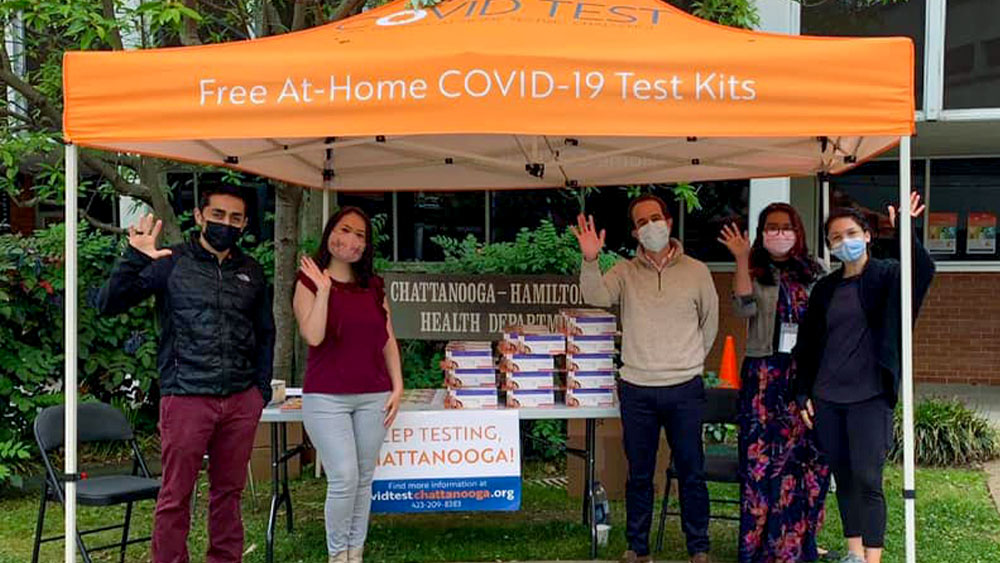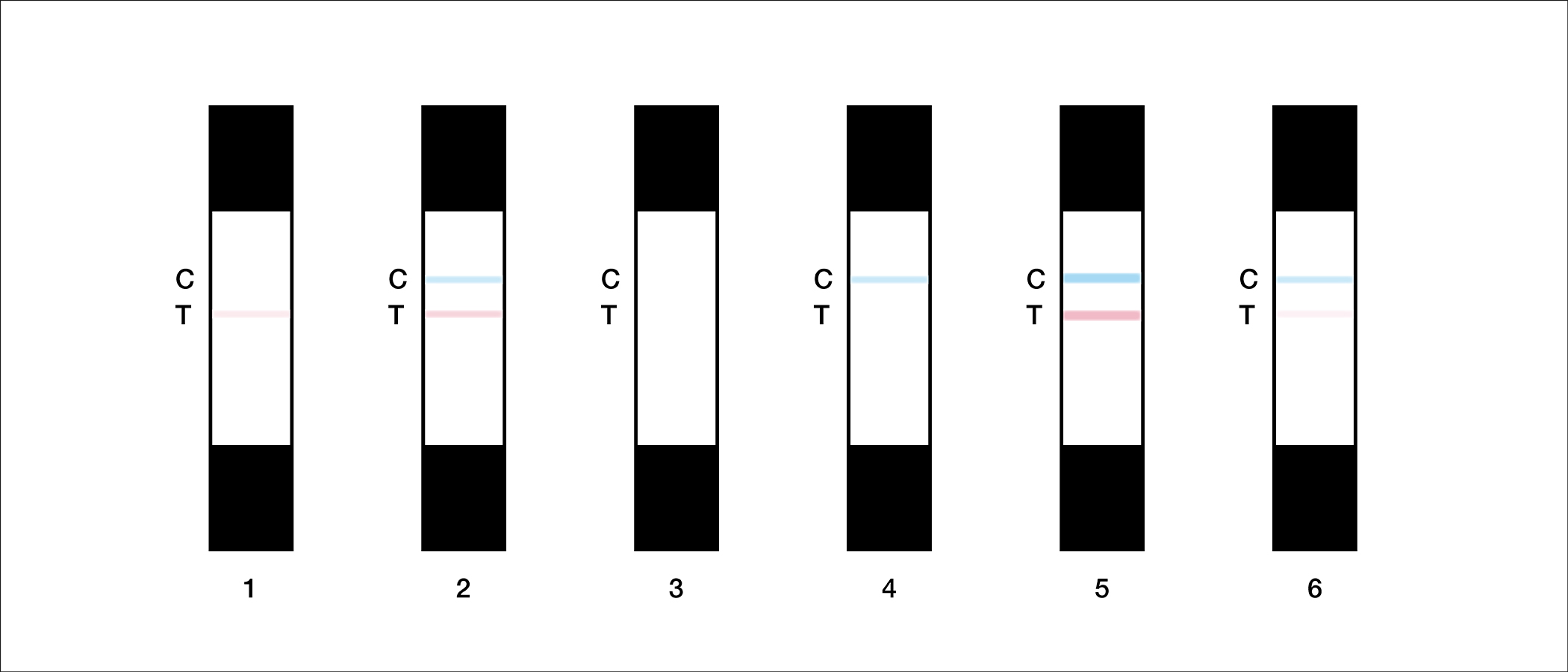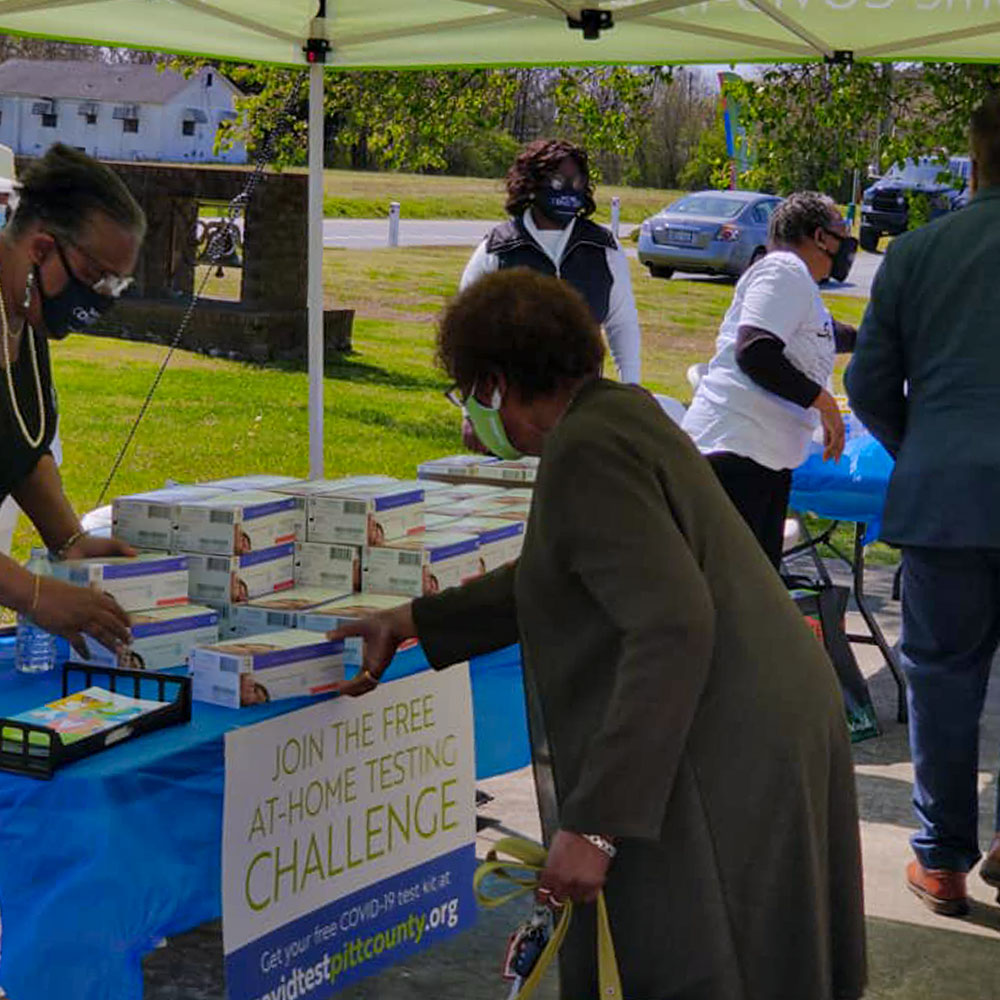Article Highlights
- People carrying SARS-CoV-2 can spread COVID-19 even if they don’t have symptoms.
-
Detecting the silent spread of COVID-19 with frequent testing may help end the pandemic.
- The Say Yes! COVID Test program has distributed free at-home tests in five U.S. communities to study the effects on virus spread.
SARS-CoV-2, the virus that causes COVID-19, doesn’t always cause symptoms, but people who have asymptomatic infections can unknowingly spread the disease.1 These asymptomatic infections may cause up to half of the viral spread in the United States.2
Tests can detect asymptomatic infections, but people rarely get tested unless they have symptoms. Going to a testing site is often inconvenient, and it can take up to a week to get the result. A week can feel like forever if you have to isolate yourself, missing days of work or school while you wait.
In the meantime, the virus keeps spreading — fueling the pandemic and allowing viral variants to develop.
Enabling asymptomatic people to test themselves in the privacy of their own homes may help to slow the spread of the virus, and NIH and the Centers for Disease Control and Prevention are trying that with the Say Yes! COVID Test. Through this program, residents of communities in select locales were invited to do free at-home tests two or three times a week for a month. If a person tested positive, they could take quick action to protect their families and others from the disease. The program started with pilot sites in North Carolina and Tennessee and later expanded to Michigan, Hawaii, and Georgia, with more sites to come.
Through Say Yes!, researchers hope to:
- Identify effective ways to promote testing and distribute test kits.
- Learn whether frequent home testing helps reduce the spread of SARS-CoV-2.
- Find out whether at-home testing influences people’s thinking and behaviors around COVID-19 testing and prevention.
Say Yes! is being funded through several NIH institutes, including the National Institute of Biomedical Imaging and Bioengineering (NIBIB) and the National Institute on Minority Health and Health Disparities (NIMHD). CareEvolution, LLC, in Ann Arbor, Michigan, developed the app used with the tests and managed the distribution logistics for online orders of tests.
The University of Massachusetts, the Duke Clinical Research Institute (DCRI) at Duke University, the Center for Health Equity Research (CHER) at the University of North Carolina at Chapel Hill, and Community Campus Partnerships for Health (CCPH) are the research teams for Say Yes! COVID Test. The U.S. Congress also provided additional funding for Say Yes! and the RADx-UP data center through the Paycheck Protection Program and Health Care Enhancement Act and the American Rescue Plan Act of 2021.
“Say Yes! gave us a chance to expand testing in our communities. We believe that providing access to convenient rapid testing could be a tool to control infections.” —Juan Marquez, M.D.

Test kits are distributed to community residents in several ways, including at pop-up events such as this one in Hamilton County, Tennessee. Photo courtesy of the Hamilton County Health Department.

Test kits are distributed to community residents in several ways, including at pop-up events such as this one in Hamilton County, Tennessee. Photo courtesy of the Hamilton County Health Department.
How the Testing Works
Once SARS-CoV-2 infects a person, it can take up to two weeks for symptoms to appear. Some people never develop symptoms. Frequent testing may help detect the virus before it spreads to others.
“We had a third wave of infections in the spring of 2021, and another surge could happen in the fall,” said Juan Marquez, M.D., medical director of the health departments of Washtenaw and Livingston counties in Michigan, west of Detroit. “Say Yes! gave us a chance to expand testing in our communities. We believe that providing access to convenient rapid testing could be a tool to control infections.”
The program uses the QuickVue At-Home COVID-19 Test, which was developed and supplied with support from the RADx Tech program, managed by NIBIB. The free tests were initially offered in bundles of 25 to residents of the participating communities, although in Georgia and Hawaii, the program moved to 4 boxes each containing 2 tests for a total of 8 tests per bundle. People either ordered the tests online or picked them up at community events, local health departments, and other distribution points. The entire testing process can be done privately at home.
“We encouraged people who have not been vaccinated yet or who work or attend school outside the home to get test kits, but anyone older than 8 was welcome to participate,” said Fernando Urrego, M.D., interim director of the health department for Hamilton County, Tennessee. Between the program’s kickoff on May 4, 2021, and conclusion on June 20, a total of 40,000 bundles had been distributed to Hamilton County households. That’s 1 million tests.
Tests require a quick swab inside each nostril. A smartphone app guides users through each step. Results are available in just 10 minutes, and users can read the test result themselves.

Try reading these test results and guessing whether each test is positive, negative, or invalid. For a test to be valid, a blue control (C) line must show. A test is positive for SARS-CoV-2 if you see a control line and a pink test (T) line, even if the test line is very faint. A test is negative if you see only a control line. A test is invalid and needs to be repeated if no lines or only a lower test line shows. The answers appear at the end of this story.

Try reading these test results and guessing whether each test is positive, negative, or invalid. For a test to be valid, a blue control (C) line must show. A test is positive for SARS-CoV-2 if you see a control line and a pink test (T) line, even if the test line is very faint. A test is negative if you see only a control line. A test is invalid and needs to be repeated if no lines or only a lower test line shows. The answers appear at the end of this story.
Community Connections
Communities are at the heart of Say Yes! COVID Test, and with support from NIH’s Rapid Acceleration of Diagnostics Underserved Populations (RADx-UP) initiative, each Say Yes! testing site builds on long-nurtured relationships with community partners — local leaders, faith-based organizations, and organizations with strong ties to groups that have a high risk for COVID-19.
Community partners generate interest and boost participation in Say Yes! COVID Test. They create opportunities for distributing tests at drive-through events, churches, grocery stores, and other places where community members gather. Partners host Facebook Live events, visit hair salons, provide goodie bags, and give out printed T-shirts to promote the program.
In Greenville–Pitt County, North Carolina, community partners and the health department distributed three out of every four tests. Only one in four was ordered online. John Silvernail, M.D., Pitt County health director, viewed the program as a unique opportunity to work with community partners to reach diverse populations and “reduce the spread of COVID-19 right here, where we live, work, learn, and play.”
Say Yes! has received remarkable interest and support from participating counties. As of October 2021, more than 2 million tests have been distributed in Tennessee, North Carolina, and Michigan.
“Through RADx-UP, we have forged strong community partnerships and put together a package of messaging that works,” explained Micky Cohen-Wolkowiez, M.D., Ph.D., of Duke University’s DCRI. Cohen-Wolkowiez and Giselle Corbie-Smith, M.D., M.Sc., director of University of North Carolina’s CHER, are leading the research team for Say Yes! COVID Test.
“The legacy of Say Yes! will be a program that communities anywhere can adapt and use to curb the spread of COVID-19 or other contagious diseases,” Cohen-Wolkowiez said.

NIH Director’s Blog on Say Yes! COVID Test
Francis Collins, M.D., Ph.D., talks about Say Yes! COVID Test as a model for communities to use to help control the COVID-19 pandemic and other disease outbreaks.

Community partners in Pitt County organized test distribution events, such as this one at Philippi Missionary Baptist Church in Simpson. Silvernail credits partner organizations as the key to getting more than half a million tests into people’s hands. “We couldn’t have done it without the partners’ commitment and hard work,” he said. Photo courtesy of Eveangel H. Savage, Ph.D.

Community partners in Pitt County organized test distribution events, such as this one at Philippi Missionary Baptist Church in Simpson. Silvernail credits partner organizations as the key to getting more than half a million tests into people’s hands. “We couldn’t have done it without the partners’ commitment and hard work,” he said. Photo courtesy of Eveangel H. Savage, Ph.D.
Collecting and Analyzing the Data
Even the data collection for Say Yes! COVID Test is done at the community level. Scientists are measuring levels of SARS-CoV-2 in wastewater (sewage) from entire communities to learn whether more widespread testing affects the amount of the virus in wastewater systems. The scientists also track numbers of emergency room visits and hospitalizations and check for other signs of community spread.
As part of a research study, some Say Yes! participants agreed to complete anonymous surveys with questions about their social interactions, doctor visits, knowledge about COVID-19, and thoughts about at-home testing. The information may help researchers understand whether frequent COVID-19 testing changed behavior. The researchers plan to analyze the data and announce the results in late 2021.
“The demand for free home tests has been significant,” according to Rachael Fleurence, Ph.D., NIH program lead for Say Yes! COVID Test. “When the program was launched in Hawaii in late September, over 600,000 tests were ordered in the first 48 hours, sending a strong signal that residents are taking immediate advantage of the convenient access to free rapid tests that can provide them with real-time information and guide their personal decisions about activities and behaviors. We hope to see home testing adopted widely as a strategy that complements vaccination and other public health measures to stop the spread of SARS-CoV-2.”
Encouraging Safety and Responsibility
SARS-CoV-2 home testing is one of several key measures available to stop the spread of COVID-19, in addition to masks, vaccines, and social distancing.
Although the data from the optional surveys won’t be available until late 2021, Urrego said that some county residents called the health department’s hotline to share their thoughts. Some callers said that testing a few times a week was challenging, but others expressed gratitude for the Say Yes! program.
“One caller said he had to go to work regularly despite the risk of being exposed to SARS-CoV-2. He actually moved out of the family home to protect a relative who had a serious immune disease,” Urrego explained. “The caller was using the home tests three times per week, knowing that as long as the results were negative, it was unlikely that he’d spread the virus. He was very grateful for the supply of home tests that allowed him to reunite with his family, at least for a few weeks.”
Sources
- Bender, J. K., Brandl, M., Höhle, M., Buchholz, U., & Zeitlmann, N. (2021). Analysis of asymptomatic and presymptomatic transmission in SARS-CoV-2 outbreak, Germany, 2020. Emerging Infectious Diseases, 27(4), 1159–1163. https://doi.org/10.3201/eid2704.204576
- Johansson, M. A., Quandelacy, T. M., Kada, S., Prasad, P. V., Steele, M., Brooks, J. T., Slayton, R. B., Biggerstaff, M., & Butler, J. C. (2021). SARS-CoV-2 transmission from people without COVID-19 symptoms. JAMA Network Open, 4(1), e2035057. https://doi.org/10.1001/jamanetworkopen.2020.35057
Quiz Answers
- Invalid result (no control line)
- Positive result (visible control and test lines)
- Invalid result (no control line)
- Negative result (visible control line but no test line)
- Positive result (visible control and test lines)
- Positive result (visible control and test lines)
 An official website of the United States government
An official website of the United States government


